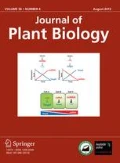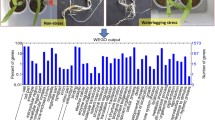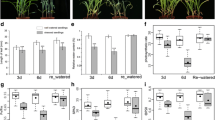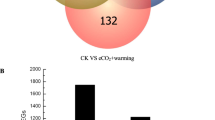Abstract
Waterlogging is a hazardous natural occurrence to constrain maize production in the high rainfall area in modern agriculture. Thus, there is need to use maize cultivars with desirable resistance to waterlogging stress to mitigate the threat. In this study, Comparative physiological and transcriptomic analysis of tropical and temperate maize lines was performed to reveal the molecular mechanisms underlying maize tolerance to waterlogging. Physiological parameter analysis showed that the tropical line “Suwan-2” sustained relatively lower peroxidase (POD), superoxide dismutase (SOD), and malondialdehyde (MDA), but higher chlorophyll, soluble carbohydrate, and soluble protein contents, as compared to the temperate line “Cim-3” under waterlogging stress. Chlorophyll fluorescence parameters Fv/Fo and Fv/Fm declined consistently and were significant higher in the tropical maize line than the temperate maize line under waterlogging stress. RNA sequencing experiments yielded 21,348 differentially expressed genes (DEGs). Among these, three sets of waterlogging-responsive DEGs were detected, including 314 specific to “Cim-3”, 1186 shared between the two lines subjected to waterlogging stress, and 259 overlapping DEGs between the two lines in control conditions. The gene ontology terms cellular process, metabolic process, plant hormone signal transduction, and catalytic activity were highly enriched in the tropical maize line “Suwan-2”. Crucial waterlogging-responsive genes in “Suwan-2” were related to transcription factor modulation, cellular redox homeostasis maintenance, plant hormone biosynthesis regulation, and metabolic process. These findings offer insight into the mechanisms underlying the waterlogging tolerance of tropical maize.







Similar content being viewed by others
Data Availability
All RNA-seq raw data are available in the NCBI SRA archive under accession number PRJNA687609.
References
Acuña TB, Dean G, Riffkin P (2011) Constraints to achieving high potential yield of wheat in a temperate, high-rainfall environment in southeastern Australia. Crop Pasture Sci 62:125–136
Ahmadi A, Emam Y, Pessarakli M (2010) Biochemical changes in maize seedlings exposed to drought stress conditions at different nitrogen levels. J Plant Nutr 33:541–556
Ahmed F, Rafii MY, Ismail MR, Juraimi AS, Rahim HA, Asfaliza R, Latif MA (2013) Waterlogging tolerance of crops: breeding, mechanism of tolerance, molecular approaches, and future prospects. Biomed Res Int 23:1–10
Arora K, Panda KK, Mittal S, Mallikarjuna MG, Rao AR, Dash PK, Thirunavukkarasu N (2017) RNAseq revealed the important gene pathways controlling adaptive mechanisms under waterlogged stress in maize. Sci Rep 7:10950
Asada K (2006) Production and scavenging of reactive oxygen species in chloroplasts and their functions. Plant Physiol 141:391–396
Ashraf MA, Ahmad MSA, Ashraf M, Al-Qurainy F, Ashraf MY (2011) Alleviation of waterlogging stress in upland cotton (Gossypium hirsutum L.) by exogenous application of potassium in soil and as a foliar spray. Crop Pasture Sci 62:25–38
Bailey-Serres J, Voesenek L (2008) Flooding stress: acclimations and genetic diversity. Annu Rev Plant Biol 59:313–339
Benjamini Y, Hochberg Y (1995) Controlling the false discovery rate: a practical and powerful approach to multiple testing. J R Stat Soc 57:289–300
Bragina TV, Rodionova NA, Grinieva GM (2003) Ethylene production and activation of hydrolytic enzymes during acclimation of maize seedlings to partial flooding. Russ J Plant Physiol 50:794–798
Cannarozzi G, Weichert A, Schnell M, Ruiz C, Bossard S, Blösch R (2018) Waterlogging affects plant morphology and the expression of key genes in tef (Eragrostis tef). Plant Direct 2:e00056
De Vetten NC, Ferl RJ (1995) Characterization of a maize G-box binding factor that is induced by hypoxia. Plant J 7:589–601
Frey FP, Urbany C, Huttel B, Reinhardt R, Stich B (2015) Genome-wide expression profiling and phenotypic evaluation of European maize inbreds at seedling stage in response to heat stress. BMC Genom 16:123
Gibbs DJ, Lee SC, Isa NM, Gramuglia S, Fukao T (2011) Homeostatic response to hypoxia is regulated by the N-end rule pathway in plants. Nature 479:415–418
Graciet E, Wellmer F (2010) The plant N-end rule pathway: Structure and functions. Trends Plant Sci 15:447–453
Hasanuzzaman M, Nahar K, Mahabub AM, Roychowdhury R, Fujita M (2013) Physiological, biochemical, and molecular mechanisms of heat stress tolerance in plants. Int J Mol Sci 14:9643–9684
Hossain MA, Uddin SN (2011) Mechanisms of waterlogging tolerance in wheat: morphological and metabolic adaptations under hypoxia or anoxia. Aust J Crop Sci 5:1094–1101
Iglesias MJ, Sellaro R, Zurbriggen MD, Casal JJ (2018) Multiple links between shade avoidance and auxin networks. J Exp Bot 69:213–228
Jackson M, Colmer T (2005) Response and adaptation by plants to flooding stress. Ann Bot 96:501–505
Jain M (2011) Next-generation sequencing technologies for gene expression profiling in plants. Brief Funct Genom 11:elr038–elr070
Kalaji HM, Bosa K, Koscielniak J, Hossain Z (2011) Chlorophyll a fluorescence—a useful tool for the early detection of temperature stress in spring barley (Hordeum vulgare L.). Omics 15:925–934
Keuskamp DH, Pollmann S, Voesenek LA, Peeters AJ, Pierik R (2010) Auxin transport through PIN-FORMED 3 (PIN3) controls shade avoidance and fitness during competition. Proc Natl Acad Sci USA 107:22740–22744
Li XF (2016) Plant physiology experiment manual (2). High Educational Press, Beijing, pp 141–158
Li W, Mo W, Ashraf U, Li G, Wen T, Abrar M (2018) Evaluation of physiological indices of waterlogging tolerance of different maize varieties in South China. Appl Ecol Environ Res 16:2059–2072
Licausi F, Dongen JTV, Giuntoli B, Novi G, Santaniello A, Geigenberger P (2010) HRE1 and HRE2, two hypoxia-inducible ethylene response factors, affect anaerobic responses in Arabidopsis thaliana. Plant J 62:302–315
Livak KJ, Schmittgen TD (2001) Analysis of relative gene expression data using real-time quantitative PCR and the 2-ΔΔCT method. Methods 25:402–408
Lone AA, Khan MH, Dar ZA, Wani SH (2018) Breeding strategies for improving growth and yield under waterlogging conditions in maize: a review. Maydica 61:1–11
Luo M, Zhao Y, Wang Y, Shi Z, Zhang P, Zhang Y, Song W, Zhao J (2018) Comparative proteomics of contrasting maize genotypes provides insights into salt-stress tolerance mechanisms. J Proteome Res 17:141–153
Ma YL, Wang HF, Wang P, Yu CG, Luo SQ, Zhang YF (2018) Effects of cadmium stress on the antioxidant system and chlorophyll fluorescence characteristics of two Taxodium clones. Plant Cell Rep 37:1547–1555
Mahajan S, Tuteja N (2005) Cold, salinity and drought stresses: an overview. Arch Biochem Biophys 444:139–158
Mao X, Cai T, Olyarchuk JG, Wei LP (2005) Automated genome annotation and pathway identification using the KEGG orthology (KO) as a controlled vocabulary. Bioinformatics 21:3787–3793
Mathur S, Jajoo A (2014) Alterations in photochemical efficiency of photosystem II in wheat plant on hot summer day. Physiol Mol Biol Plants 20:527–531
Meyer RS, Purugganan MD (2013) Evolution of crop species: genetics of domestication and diversification. Nat Rev Genet 14:840–852
Min H, Chen C, Wei S, Shang X, Sun M, Xia R, Liu X, Hao D, Chen H, Xie Q (2016) Identification of drought tolerant mechanisms in maize seedlings based on transcriptome analysis of recombination inbred lines. Front Plant Sci 7:1080
Nakano T, Suzuki K, Fujimura T, Shinshi H (2006) Genome-wide analysis of the ERF gene family in Arabidopsis and rice. Plant Physiol 140:411–432
Parent C, Capelli N, Berger A, Crèvecoeur M, Dat JF (2008) An overview of plant responses to soil waterlogging. Plant Stress 2:20–27
Pérez-Jiménez M, Hernández-Munuera M, Piñero MC, López-Ortega G, Amor FM (2018) Are commercial sweet cherry rootstocks adapted to climate change? Short-term waterlogging and CO2 effects on sweet cherry cv. ‘Burlat.’ Plant Cell Environ 41:908–918
Petrov V, Hille J, Mueller-Roeber B, Gechev TS (2015) ROS-mediated abiotic stress-induced programmed cell death in plants. Front Plant Sci 6:69
Qiu FY, Zhang ZZ, Xu S (2007) Mapping of QTL associated with waterlogging tolerance during the seedling stage in maize. Ann Bot 99:1067–1081
Rasheed R, Iqbal M, Ashraf MA, Hussain I, Shafiq F, Yousaf A (2018) Glycine betaine counteracts the inhibitory effects of waterlogging on growth, photosynthetic pigments, oxidative defence system, nutrient composition, and fruit quality in tomato. J Hortic Sci Biotechnol 93:385–391
Robinson MD, McCarthy DJ, Smyth GK (2010) edgeR: a Bioconductor package for differential expression analysis of digital gene expression data. Bioinformatics 26:139–140
Saab IN, Sachs MM (1996) A flooding-induced xyloglucan endo-transglycosylase homolog in maize is responsive to ethylene and associated with aerenchyma. Plant Physiol 112:385–391
Sarka R, Reddy J, Sharma S, Ismail AM (2006) Physiological basis of submergence tolerance in rice and implications for crop improvement. Curr Sci 91:899–906
Sasidharan R, Voesenek LA (2015) Ethylene-mediated acclimations to flooding stress. Plant Physiol 169:3–12
Setter T, Belford B (1990) Waterlogging: how it reduces plant growth and how plants can overcome its effects. J Dep Agric West Aust Ser 4:51–55
Setter T, Waters I (2003) Review of prospects for germplasm improvement for waterlogging tolerance in wheat, barley and oats. Plant Soil 253:1–34
Shabala S (2011) Physiological and cellular aspects of phytotoxicity tolerance in plants: the role of membrane transporters and implications for crop breeding for waterlogging tolerance. N Phytol 190:289–298
Shabala S, White RG, Djordjevic MA, Ruan YL, Mathesius U (2016) Root-to-shoot signalling: integration of diverse molecules, pathways and functions. Funct Plant Biol 43:87–104
Shan X, Li Y, Jiang Y, Jiang Z, Hao W, Yuan Y (2013) Transcriptome profile analysis of maize seedlings in response to high-salinity, drought and cold stresses by deep sequencing. Plant Mol Biol Reporter 31:1485–1491
Shinde H, Tanaka K, Dudhate A, Tsugama D, Mine Y, Kamiya T, Gupta SK, Liu S, Takano T (2018) Comparative de novo transcriptomic profiling of the salinity stress responsiveness in contrasting pearl millet lines. Environ Exp Bot 155:619–627
Su LY, Dai ZW, Li SH, Xin HP (2015) A novel system for evaluating drought–cold tolerance of grapevines using chlorophyll fluorescence. BMC Plant Biol 15:82–94
Subbaiah CC, Kollipara KP, Sachs MM (2000) A Ca2+-dependent cysteine protease is associated with anoxia-induced root tip death in maize. J Exp Bot 51:721–730
Sumesh KVP, Sharma-Natu C, Ghildiyal C (2008) Starch synthase activity and heat shock protein in relation to thermal tolerance of developing wheat grains. Biol Plant 52:749–753
Tang W, Zhang Z, Zou X, Zheng Y (2005) Functional genomics of maize submergence tolerance and cloning of the related gene Sicyp51. Sci China C Life Sci 48:337–345
Tang B, Xu SZ, Zou XL, Zheng YL, Qiu FZ (2010) Changes of antioxidative enzymes and lipid peroxidation in leaves and roots of waterlogging-tolerant and waterlogging-sensitive maize genotypes at seedling stage. Agric Sci China 8:651–661
Thirunavukkarasu N, Hossain F, Mohan S, Shiriga K, Mittal S, Sharma R, Singh RK, Gupta HS (2013) Genome-wide expression of transcriptomes and their co-expression pattern in subtropical maize (Zea mays L.) under waterlogging stress. PLoS ONE 8:1–12
Tian LX, Bi WS, Liu X, Sun L, Li J (2019) Effects of waterlogging stress on the physiological response and grain-filling characteristics of spring maize (Zea mays L.) under field conditions. Acta Physiol Plant 41:1–14
Trapnell C, Roberts A, Goff L, Pertea G, Kim D, Kelley DR, Pimentel H, Salzberg SL, Rinn JL, Pachter L (2012) Differential gene and transcript expression analysis of RNA-seq experiments with TopHat and Cufflinks. Nat Protoc 7:562–578
Wang Z, Gerstein M, Snyder M (2009) RNA-Seq: a revolutionary tool for transcriptomics. Nat Rev Genet 10:57–63
Wang H, Wang H, Shao H, Tang X (2016) Recent advances in utilizing transcription factors to improve plant abiotic stress tolerance by transgenic technology. Front Plant Sci 7:67
Wang CT, Ru JN, Liu YW, Yang JF, Li M, Xu ZS, Fu JD (2018) The maize WRKY transcription factor ZmWRKY40 confers drought resistance in transgenic Arabidopsis. Int J Mol Sci 19:2580
Wu TD, Nacu S (2010) Fast and SNP-tolerant detection of complex variants and splicing in short reads. Bioinformatics 26:873–881
Yan K, Zhao S, Cui MX, Han GX, Wen P (2018) Vulnerability of photosynthesis and photosystem I in Jerusalem artichoke (Helianthus tuberosus L.) exposed to waterlogging. Plant Physiol Biochem 125:239–246
Young M, Wakefield M, Smyth G, Oshlack A (2010) Gene ontology analysis for RNA-seq: accounting for selection bias. Genome Biol 11:R14
Yu Q, Shen Y, Wang Q, Wang X, Fan L, Wang Y (2019) Light deficiency and waterlogging affect chlorophyll metabolism and photosynthesis in Magnolia sinostellata. Trees 33:11–22
Zaidi PH, Rafique S, Rai PK, Singh NN, Srinivasan G (2004) Tolerance to excess moisture in maize (Zea mays L.): susceptible crop stages and identification of tolerant genotypes. Field Crop Res 90:189–202
Zaidi PH, Maniselvan P, Srivastava A, Yadav P, Singh RP (2010) Genetic analysis of waterlogging tolerance in tropical maize (Zea mays L.). Maydica 55:17–26
Zenda TS, Liu ST, Wang X, Liu G, Jin HY, Dong AY, Yang YT, Duan HJ (2019) Key maize drought-responsive genes and pathways revealed by comparative transcriptome and physiological analyses of contrasting inbred lines. Int J Mol Sci 20:1268
Zhang ZX, Tang WH, Tao YS, Zheng YL (2005) cDNA microarray analysis of early response to submerging stress in Zea mays roots. Russ J Plant Physiol 52:43–49
Zhao N, Li CW, Yan YJ, Cao W, Song AP, Wang HB, Chen SM, Jiang JF, Chen FD (2018) Comparative transcriptome analysis of waterlogging sensitive and waterlogging tolerant Chrysanthemum morifolium cultivars under waterlogging stress and reoxygenation conditions. Int J Mol Sci. https://doi.org/10.3390/ijms19051455
Acknowledgements
This project was supported by National Natural Science Foundation of China (No. 31371633) and University Outstanding Achievements Transfer Aid Project of Chongqing Municipal Education Commission (CGZH1633).
Author information
Authors and Affiliations
Corresponding author
Ethics declarations
Conflict of interest
The authors declare no conflict of interest.
Supplementary Information
Below is the link to the electronic supplementary material.
Rights and permissions
About this article
Cite this article
Yao, Q. Crucial Waterlogging-Responsive Genes and Pathways Revealed by Comparative Physiology and Transcriptome in Tropical and Temperate Maize (Zea mays L.) inbred Lines. J. Plant Biol. 64, 313–325 (2021). https://doi.org/10.1007/s12374-021-09298-2
Received:
Revised:
Accepted:
Published:
Issue Date:
DOI: https://doi.org/10.1007/s12374-021-09298-2




